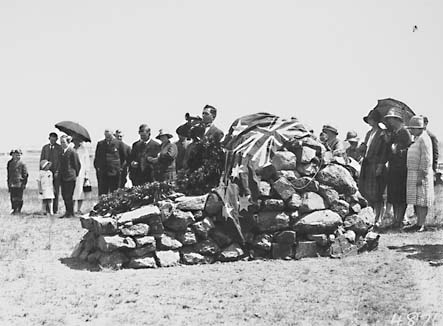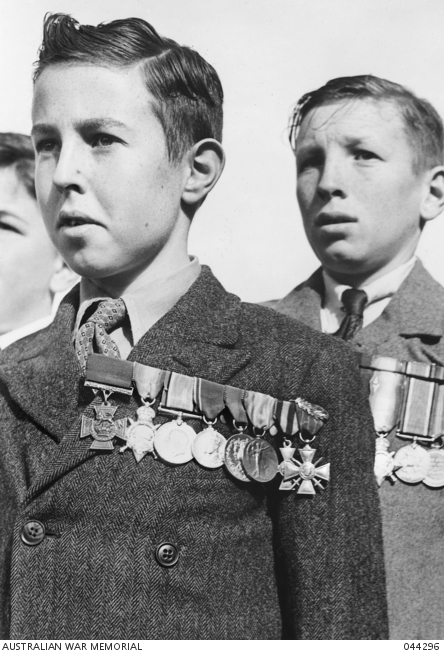Honest History has been interested in the Anzac Centenary Local Grants Program (ACLGP) since it commenced. We will update this Factsheet as often as we can.
Program
The ACLGP provides up to $125 000 for approved projects in each of the 150 federal electorates. The total cost of the program is thus $18 750 000.
 Official dedication of Australian War Memorial site and cairn with bugler and spectators, 1928 (National Archives of Australia, A3560, 3149675)
Official dedication of Australian War Memorial site and cairn with bugler and spectators, 1928 (National Archives of Australia, A3560, 3149675)Applications for grants are approved by the Minister for Veterans’ Affairs. Applications closed on 30 May 2014. The Department of Veterans’ Affairs advised Honest History some time ago that the period for applications had been extended for three months from the original closing date of 28 February 2014. Some applications have had to be returned to applicants for revision.
Progress
At 5 June 2014, 67 projects in 30 electorates had been approved with a total value of $938 072. This figure was tallied by Honest History after DVA advised that there was no publicly available tally for the program overall. Honest History added together information for individual electorates. Official aggregates would assist transparency and it is difficult to understand their absence.
Honest History also asked DVA how many applications remained to be approved under the ACLGP and whether they were for roughly the same average value of the projects approved to date (around $14 000). DVA advised that, while it was not in a position to answer these specific questions, grant applications are provided to the Minister for consideration once they have been assessed as compliant and that this process continued.
DVA further advised that it complies with the reporting guidelines mandated by the Financial Management Act and the Commonwealth Grant Guidelines. Grants approved by the Minister are reported on the DVA website within 14 days after the grant agreement takes effect.
Baghdad, Iraq, 25 September 1992. Seen from across an ornamental lake are the two half domes which form the Monument of Saddam Hussein’s Qadissya Martyrs.
The monument is a war memorial to the dead from the Iran-Iraq war from 1980-88 and contains the names of over one million Iraqi war dead. (Australian War Memorial, P02000.012)
While any projections of the future of the program must be purely speculative, one scenario is as follows: if the projects approved in future are worth the same average value as those approved so far, that is, $14 000, and if the budgeted amount of $18 750 000 is to be fully spent, then the Minister will have to approve approximately 1272 projects ($18 750 000 less $938 072 equals $17 811 928 divided by $14 000 equals 1272.28).
While the Minister and his Labor predecessor have to date approved just 67 projects it needs to be remembered that applications have only recently closed. Honest History has no way of knowing details of the projects awaiting approval but the 67 approved so far include just six projects worth $40 000 or more, with a couple of others just under that benchmark. Perhaps there are bigger projects in the pipeline. More expensive projects would use up the funds more rapidly. For example, projects averaging $40 000 in value would only require approximately 445 strokes of the ministerial pen.
The program includes a number of contingency arrangements. If an electorate’s allocation has not been exhausted, applications after 30 May 2014 may be considered. If a funded project cannot go ahead the money can be redistributed to other projects within the electorate. If an electorate’s allocation is not taken up the unused money goes into a central pool for the State or Territory.
Projects
What sort of projects are being approved? Table 1 below shows Honest History’s tally of the number and value of the first 67 approved projects against the criteria for eligibility. (The criteria are listed in full in the Appendix to this post.) The projects which are most difficult to categorise are those involving events and research. For example, some projects intended to produce commemorative printed material might match both criterion 1 and criterion 5.
Table 1: ACLGP projects approved as at 5 June 2014 against eligibility criteria
| No. | Value $ | Av. Value $ | |
| Memorials and monuments (criteria 2 & 3) | 34 | 638 139 | 18 769 |
| Events and research (criteria 1 & 5) | 29 | 292 938 | 10 101 |
| Preservation (criterion 4) | 4 | 6995 | 1749 |
| Total | 67 | 938 072 |
To sum up, just over half of the projects approved so far involve the building of new memorials and monuments (18 projects worth $391 495) and the refurbishing of old ones (16 projects worth $246 644). These projects account for 68 per cent of the money allocated to date.
Pick of the projects
Details of approved grants by electorate are publicly available in Excel spreadsheets. It is not clear whether these spreadsheets are the only information that is before the Minister when he makes approval decisions. Some notable projects include:
- $20 000 to the St Mary’s RSL sub-branch to help restore a memorial rotunda (electorate of Lindsay, NSW);
- $100 000 to a community committee at Baulkham Hills for six community programs, 18-25 April 2015 (Mitchell, NSW);
- $39 150 to the Cocos (Keeling) Islands Tourism Association to build a Sydney-Emden memorial (Lingiari, NT);
- $34 000 to the Samford RSL sub-branch to plant an avenue of honour (Dickson, Qld);
- $2970 to each of five schools (via a production company) in Adelaide for ‘Do not forget’, a commemorative theatrical production for students (Kingston, SA);
- $100 000 to the Boronia RSL sub-branch to upgrade a memorial arboretum (Aston, Vic);
- $37 300 to the City of Greater Dandenong to construct walking trails to explore sites and stories in the city that have Great War significance (Isaacs, Vic.);
- $52 965 to the Little River Historical Society for a memorial to Australian nurses in World War I (Lalor, Vic.);
- $6171 to the Stawell RSL sub-branch for seven World War I uniforms for school army cadets to wear in Anzac Day ceremonies (Mallee, Vic.); and
- $6000 to the Ararat Legacy Club to help restore Brudenell White memorial (Wannon, Vic.).
Questions arising
1. Are the 67 projects approved so far just the tip of a massive centenary project iceberg of mainly small projects or are there some relatively chunky projects coming?
2. Will the budgeted money be spent on the original basis of $125 000 per electorate or will the contingency arrangements have to kick in?
3. Will the preponderance of memorials and monuments projects continue?
(DVA noted these questions but advised that it could not answer them, as to do so would require speculation on the Minister’s decisions on grant applications.)
Two Melbourne schoolboys wearing their father’s medals during World War II. The boy in front is Maurice Smith, the son of Issy Smith, born Ishroulch Shmeilowitz in 1890 in Egypt. He was awarded the Victoria Cross for action at Ypres in 1915 and later the Russian Cross of St George and the French Croix de Guerre.
The full Australian War Memorial caption to the photograph gives further details and points out the mistakes in the ribbons and order of precedence of the medals being worn. (Australian War Memorial, 044296)
Appendix
From ‘Guidelines for the public‘, p. 2 (the criteria in dot points below have been designated as criteria 1-5 in this Factsheet).
What is eligible?
Proposed projects and events must be directly commemorative of the involvement, service and sacrifice of Australia’s servicemen and women in the First World War.
Types of projects eligible under this program include:
- public commemorative events, including the commemoration of important military anniversaries, enlistments and other First World War events that have had a significant impact on the local community;
- new First World War memorials or honour boards;
- the restoration of existing First World War memorials or honour boards;
- the preservation, interpretation and display of First World War wartime and military memorabilia and artefacts; and
- relevant school projects, such as research with a focus on military involvement and social impacts, and the products of research, e.g. written material, documentaries etc.
5 June 2014




Leave a Reply
You must be logged in to post a comment.